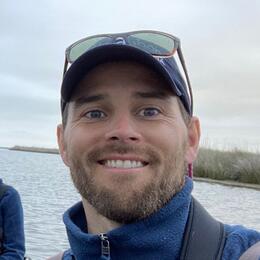On a clear August morning, shortly after a rainstorm brushed across Cape Lookout National Seashore, Audubon Coastal Biologist Lindsay Addison knelt on the beach and held a baby Black Skimmer gently in her hand. The bird wriggled for a moment, snapped its gawky bill twice, then settled into her palm.
“They get a little excited at first,” Addison said as she clasped a black plastic band to its left leg and a metal band to its right. “But it doesn’t take long once they settle down. And now that this guy is banded, we’ll be able to keep tabs on where it travels, whether it heads to South Carolina or migrates all the way to Florida.”
The lightweight band will allow researchers and birdwatchers to identify this individual skimmer wherever it might roam, and is part of a larger effort across the North Carolina coast to figure out how skimmers are moving through their range.
Despite local strongholds for the species, North Carolina’s breeding skimmer population appears to be in steep decline. The North Carolina Colonial Waterbird Census, which takes place every three years, showed skimmer nest numbers dropping from 842 in 2014 to 323 last year, a decline of 62 percent. Biologists aren’t sure exactly why, but tracking the birds may provide answers.

Skimmer Stonghold
Among the places where skimmers are thriving is Cape Lookout National Seashore, located in Carteret County just south of Cape Hatteras National Seashore. “The seashore is 56 miles of undeveloped beach that is allowed to do what barrier islands do,” said Jon Altman, supervisory biologist at Cape Lookout National Seashore.
When storms pass over the island, surging waves form natural inlets and flatten the dunes, creating open stretches of sand that skimmers need to nest. “That’s why the bird habitat is so good, that’s why they’re attracted to it,” he said.
Altman and his team spend their time patrolling the beach, managing habitat for bird colonies and nesting sea turtles. They also helped Addison band skimmers. Over the course of several hours, the crew attached bands to the legs of two dozen birds, all of them juveniles. Unlike adult skimmers, with their striking black-and-white plumage, the young skimmers have mottled, tan-colored feathers on their backs. This allows the flightless chicks to blend in with their sandy environment until they’re old enough to fly.
By tracking the skimmers as they mature, migrate, and potentially return to the breeding grounds where they were born, biologists will learn more about the threats they face, here and far away.
“We know where they nest and where they do well,” Altman says. “It would be really helpful to know where they move after nesting. Do they winter locally? Do they winter internationally? We want to learn how Cape Lookout’s skimmer colonies fit into the larger picture for these birds.”
Banding Takes Flight
Over the past three years, Addison has banded more than 350 skimmers on the North Carolina coast, working at Audubon-managed sites and with the NC Wildlife Resources Commission to band at one of their skimmer colonies. This was the first season at Cape Lookout.
The North Carolina skimmer program joins several other states that are also investigating the movements of skimmers. Since banding began, biologists have learned that North Carolina serves as a huge staging ground during migration. Birds banded in other states along the Atlantic coast have showed up at our state’s natural inlets to rest and feed during their travels. Protecting these places is a key part of helping skimmers survive and thrive.
Banding also gives Addison a glimpse into the stories of individual birds, which may be re-spotted by researchers far away or even by Addison herself, when they return to the exact same beach to nest.
Already this summer, Addison spotted a skimmer at the south end of Wrightsville Beach that she hadn’t seen since she banded the bird when it was an ungainly youngster in 2019. Biologists at Pea Island National Wildlife Refuge have recorded another chick banded just this summer at Wrightsville visiting their Oregon Inlet skimmer roost 160 miles away, and several more of this year's young just turned up on Ocracroke Island, according to reports from Cape Hatteras staff.
So far, none of the banded chicks from previous years have been recorded nesting, but over a dozen returned to their natal colony this year. With Audubon staff, volunteers, and partners around the state looking out for bands, it’s a good bet that they will soon.





